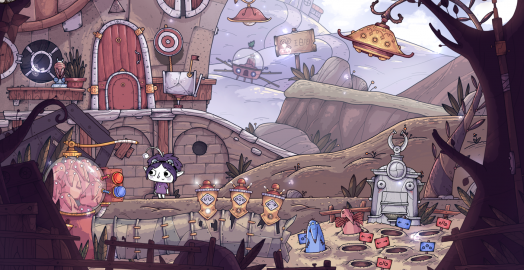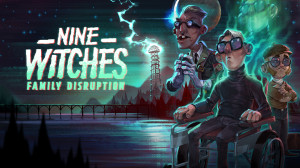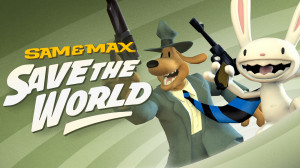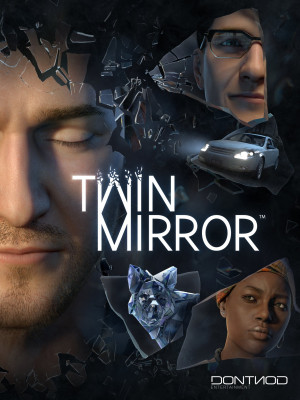Review for TOHU

Amanita Design's influence on the adventure genre runs deep these days. Where LucasArts, Sierra, and Cyan helped form the templates that would define most point-and-click games for years, relatively recent hits like Machinarium and Samorost from the indie Czech developer were bound to inspire imitators as well. One such game is TOHU, a cute and challenging little point-and-click adventure from Fireart Games that – with its carefully considered color palette, a wealth of puzzles in a panoply of styles, and even its odd and unexplained name – not only follows closely in Amanita’s footsteps, it does so pretty darn well.
In TOHU's opening scenes, a shadowy figure demolishes a large machine referred to as the “Sacred Engine,” which we’re told by a deep-voiced narrator is somehow essential to life on this fish-shaped planet. The goal of repairing the machine becomes the game’s MacGuffin, as you set off in your bug-powered spaceship on a roughly five-hour, puzzle-filled chase throughout a cloudy void in which all the worlds are floating sea creatures covered in mechanical junk. As you search for the missing parts of the Sacred Engine and the magical totem pole that powers it, you’ll be chased throughout and sabotaged by the mysterious hooded figure. Your adventure will bring you into contact with pirates, robots, giant insects, a time machine, and a host of other wonders and monstrosities. It's a fairy tale wonderland of whimsy and strangeness, all packed into incredibly cluttered but amazingly illustrated rooms.
You control a little goblin-looking creature simply known as “the Girl,” gifted with the unique ability to turn herself into a sort of mechanical golem with a floating cube for a head. Together they represent dual heroes traipsing around this odd universe, helping out its adorably bizarre citizens along the way. While the Girl has the ability to climb structures and talk with various weird creatures across the different planets, the golem, named Cubus, has incredible strength, granting it the power to lift and move large objects. Both of these abilities will come in handy as you navigate the strange worlds before you.
TOHU is entirely mouse-driven, and your cursor serves two functions. Depending on what you click, you either directly interact with an object as a force from beyond the screen, or you instruct your character to do so on your behalf. Changing between the two protagonists can be done any time simply by clicking on the current avatar’s sprite. There’s an inventory in the upper left corner of the screen and a menu in the upper right that lists your current goals and the collectibles you've acquired so far, as well as provides an option for game hints.
Each scene, from caves to houses to carnivals, is beautifully drawn and packed full of so many points of interest that it can be overwhelming at first. This feeling is compounded by the fact that hotspots do not highlight, nor are they captioned by hovering over them with your cursor. It's impossible to tell what can and can't be interacted with unless you try it, which leads to spending the first few minutes in any room clicking wildly on the piles of junk and characters and creatures flitting around.
Clicking many objects of interest will yield unique results. A bug may fly to a different part of the screen where the Girl or Cubus can better interact with it, for example. In other cases, clicking will guide the protagonist to interact with the item or talk to the selected character. Certain things can be collected (represented as cards, in a book) for an achievement. In some instances, whatever you click on will just dance or move around to provide a second of entertainment, such as an insect zipping into holes or objects simply spinning around. Frustratingly, however, things that cannot be interacted with yet will not prompt a clue or an animation of your character attempting to interact and failing, just a simple head shake and an “Uh uh.” In scenes so full of things to do and explore, the absence of feedback is felt strongly and can add even more to that sense of being flustered by all the possibilities.
You usually progress one tiny planet at a time, with each world being generally three to five screens large. Because scouring each scene can feel like such a daunting undertaking, I regularly took a break whenever I reached a new area. Seeing the glut of new objects on-screen, I'd find myself feeling a little resistant to clicking around for several minutes until I was sure I got everything. However, when I'd return with my energy recharged, it was nice to have so much new to learn and explore each time I loaded up the game. While it would have been nice to have better feedback about what doesn’t work in any given area, I can't fault the designers for wanting to pack more content into every bit of real estate, and it has the positive side effect of making the universe feel full and realized.
Whether because of, or in spite of this lack of hand-holding, it’s as a puzzle game that TOHU truly shines. It employs a diverse wealth of puzzle styles from the last thirty years of point-and-click adventure gaming, most of which are executed expertly in their own unique way. There are inventory items to collect, combine, and use in both obvious and not-so-obvious ways. There are puzzles that spring out of the environment, where particular elements in the scene need to be manipulated for new areas to be accessed. There are standalone logic puzzles like gear or pipe circuits that must be completed using a limited amount of connections. The list goes on: problems in which items must be traded between various characters; pattern challenges, where a pattern must be observed and repeated in different rooms or circumstances; symbol-based combination locks; and even time-travel puzzles, where things that you affect in the past will impact the future.
Solving my way through this bizarre collection of obstacles was a true highlight of TOHU, except for two tired genre tropes that unfortunately popped up: the Container Puzzle, and the River Crossing Puzzle. For those who don't know, the Container Puzzle is an infamous brainteaser wherein you need to arrive at a certain measurement of liquid using two unequal containers (such as using a 5L and a 3L container to make 4L). The River Crossing Puzzle is an ancient logic problem where you must transport three entities across a river, but neither can be left alone with one of the others. In a game so stuffed full of distinctive takes on classic puzzle styles, it was disappointing to see a pair of over-used retreads thrown in.
There are also a few mini-games to win along the way. Most of these are harmless diversions, like simple rotating mazes or re-assembling the pieces of a shattered mirror, but about halfway through you’ll encounter a reverse-whack-a-mole game that is infuriating. Here you play the mole as hammers come down, indicated by shadows, in larger numbers and at faster speeds. You must survive three rounds or you can't progress in the game. One hit and you’re done. There is no pattern to memorize, and no way to bypass it. You just bang your head against it until it's finished. It felt like a sudden betrayal of the rest of the gameplay, which relies pretty solely on experimentation and wits. Suddenly you're in a position where there's no way forward but to overcome a particularly difficult challenge of reaction, speed, and skill. Unless the puzzle is redesigned to be more manageable or a skip function implemented, I imagine there will be adventure game lovers who will hit this spot and advance no further, which is a shame.
With those few notable exceptions, however, TOHO has a good mix and balance of puzzles throughout the adventure. Ranging in style and difficulty, they make the game consistently challenging and rewarding, and will keep your brain adjusting and adapting with every new scene. Many of the puzzles are contained on a single screen, but there is also a fair bit of hopping back and forth with a new item or after making some kind of change to the environment. If you're having trouble, the game does offer an intriguing hint mechanic in the form of a finicky timing-based mini-game. A pointer spins around a wheel of buttons and you have to time your clicks just right to make the pointer hit the buttons. One miss and it resets. It can take a while to master, but when you do, you're treated to a pictorial map that will outline all the goals and solutions in each scene. For a game so dense and bizarre, I was thankful for this hint mechanic a few times in my playthrough.
All the while, the score playing in the background is light and airy throughout with melodic piano, strings, and muted horns. It gives the game a gentle, calm feeling that offers some welcome contrast to its visually cluttered environments. As the clicks and whirs of unusual machinery happen all around, it's a balm to be treated with soothing music. There is very little voice work, as most of the characters either communicate in soft, expressive grunts with pictorials showing their thoughts, or through overlays of speech bubbles next to a portrait of the character talking. There are no dialogue trees or options, as any conversation is largely instructional or expositional when it happens.
All in all, I was delightfully surprised by TOHU. The game takes you on a wonderfully weird romp through a universe full of odd creatures and challenges. Rather than the traditional point-and-click adventure I was expecting, I found myself exercising every part of my puzzle-solving cortex (we have one of those, right?) all the while enjoying the cute little tale it told. The fine line between graphic adventure and puzzle game is expertly walked, and while I was occasionally overwhelmed by the sheer level of excess at times, by pacing myself I was always left feeling satisfied. If story is the reason you come to adventure games, TOHU is pretty lightweight, but if you enjoy beautiful animation and artwork and solving puzzles, this game more than delivers.
Evaluation copy graciously provided by GOG.com






























